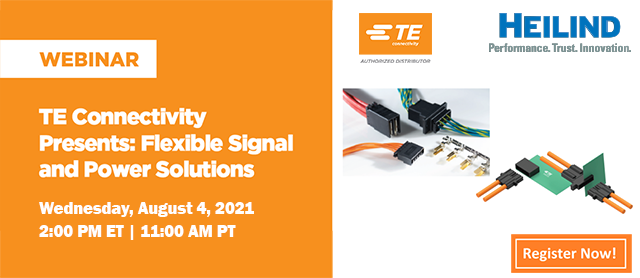The automotive industry is experiencing a surge in new technologies and features, from alternative power sources to fully autonomous vehicles. Electronics now commonly represent over half of a vehicle’s value. Every new feature added requires a new module, known as an electronic control unit (ECU). The latest vehicles employ between 100 and 150 such ECUs each with their own dedicated connections and wiring. These, along with an ever-growing number of sensors, motors and other components, have created an enormous demand for connectivity solutions.
Vehicle manufacturers are confronting a critical challenge: dwindling space within the vehicle to accommodate these expanding systems. The wiring necessary to connect many hundreds of components means that cable harnesses are now among the most complex structures within vehicle manufacturing, and the next generation of vehicles will deliver even more functionality. As vehicles evolve to offer even greater capabilities, demand intensifies for compact, high-performance connectors that withstand harsh conditions.
Solving for Growing Complexity
The next generation of vehicles will be defined by the new technologies that are now being introduced into the automotive industry. Manufacturers are keen to take advantage of the latest 5G wireless communication to improve safety and user experience. Vehicles will be part of a dynamic network in which information is shared with other road users and even traffic control infrastructure to make travel safer and more efficient. This vehicle-to-everything (V2X) communication will require vehicles equipped with more sensors, controls and computing power than ever before.
This will be even more critical in the much publicized — and much anticipated — move toward autonomous or “self-driving” vehicles. Advanced driver assistance systems (ADAS) are already providing motorists with sophisticated solutions for road safety. Interaction with other road users will depend upon systems that can collect, analyze and act upon information about their surroundings with the lowest possible latency.
However, the automotive environment is a challenge for safety-critical systems. Even a momentary break in connection caused by vibration can lead to the loss of immense amounts of critical information. Designers will require a range of miniaturized connector solutions that are tolerant of vibration while delivering data speeds many times higher than those seen in the automotive world today.
Enabling New Vehicle Architectures
With roughly a mile of wire and hundreds of connectors in every vehicle, the volume of copper cabling directly impacts vehicle performance, especially when we are being encouraged to adopt smaller and more efficient modes of transport. The weight of such a large amount of copper cabling is a drain on the range and performance of vehicles. Attempts to solve this problem have led to the concept of zonal architecture.
Zonal architecture is an approach to structuring vehicle electronics. In contrast to domain architecture in which systems are grouped by function, zonal architecture offers a more efficient solution. The functions within a vehicle are grouped by location into several zones. Each zone is responsible for the devices installed in a particular section of the vehicle and connected to a zonal controller or gateway in the vicinity. Because a zonal gateway is close to the devices it controls, the cable lengths required to connect them are relatively short, resulting in an increased need for reliable miniaturized connectors for these short cables.
Each zonal gateway is connected to the central computing cluster at the heart of the vehicle. The communication between zonal gateways and the central computer resembles a computer network. As a result, inter-zonal communication can take place over small, high-speed networking cables that greatly reduce the quantity and size of the harness that must be installed around the vehicle.
Zonal architecture is also creating a new way of looking at the distribution of power and high-speed communication. Conventional vehicle power is supplied at 12V, but the adoption of voltages up to 48V allows a corresponding reduction in current to deliver the same amount of energy to devices. This in turn allows designers to employ smaller gauge wires and smaller connectors. In just one example, a 48V system can use 10 AWG wire instead of 4 AWG to deliver the same energy as its 12V equivalent. This can create a weight saving of up to 85% in wiring alone. Across an entire vehicle harness, this weight saving has a considerable impact on efficiency.
Miniaturized Connectors Bring it all Together
Zonal architecture is introducing changes to vehicle manufacturing that affect connector design. The connectivity between a device and zonal gateway will require a new generation of hybrid or mixed connectors that can carry both power and high-speed signals such as the stAK50h connector system from Molex. It offers mixed contact capability, allowing the designer to combine signal, data and power functionality in each connector, minimizing the space required. Its stacking housing simplifies harness design and installation and complies with USCAR-2 and global automotive OEM standards, simplifying adoption.
Not all connectors will be exposed to exterior conditions — new solutions “inside the box” will also be required. Connectors for use in the central computing cluster will need to provide high density and low profiles, even while delivering a large number of circuits. Existing wire-to-board solutions offer the connectivity required, but they lack the robust performance to withstand the constant shock and vibration of automotive applications.
The DuraClik wire-to-board connectors from Molex have been designed to deliver stable mating and high PCB retention force in applications that require strong anti-vibration capability. The DuraClik family has been extensively tested, conforming to LV214 and ES91500-03 specifications for the European, Chinese and U.S. automotive markets.
Miniaturized connectors are key to delivering expanding functionality. The ConnTAK50 system from Molex offers a single- and dual-row connector system in small package sizes that make it easier to design-in new capabilities. The ConnTAK50 terminal uses a 2-piece beam design, offering greater resistance to vibration while delivering superior electrical performance. With up to 22 circuits and a current rating of up to 6 Amps per contact, the compact package of the ConnTAK50 system offers space savings, even when compared to the Molex Mini50 connector.
Molex: A Solution for the Future
The introduction of zonal architecture represents the greatest change in vehicle design for decades. Vehicles that employ zonal architecture will require less wiring, saving weight and cost, while increasing capability. However, the growing functionality of next generation vehicles will place greater demands on space. Designers will need methods for connecting power and high data speeds in the tough automotive environment, while still delivering the high reliability that consumers expect.
Innovative miniaturized connectivity solutions from Molex provide rugged and reliable performance for the harsh conditions of the automotive environment. Their small size and light weight are making a positive contribution to efficiency in the industry.




